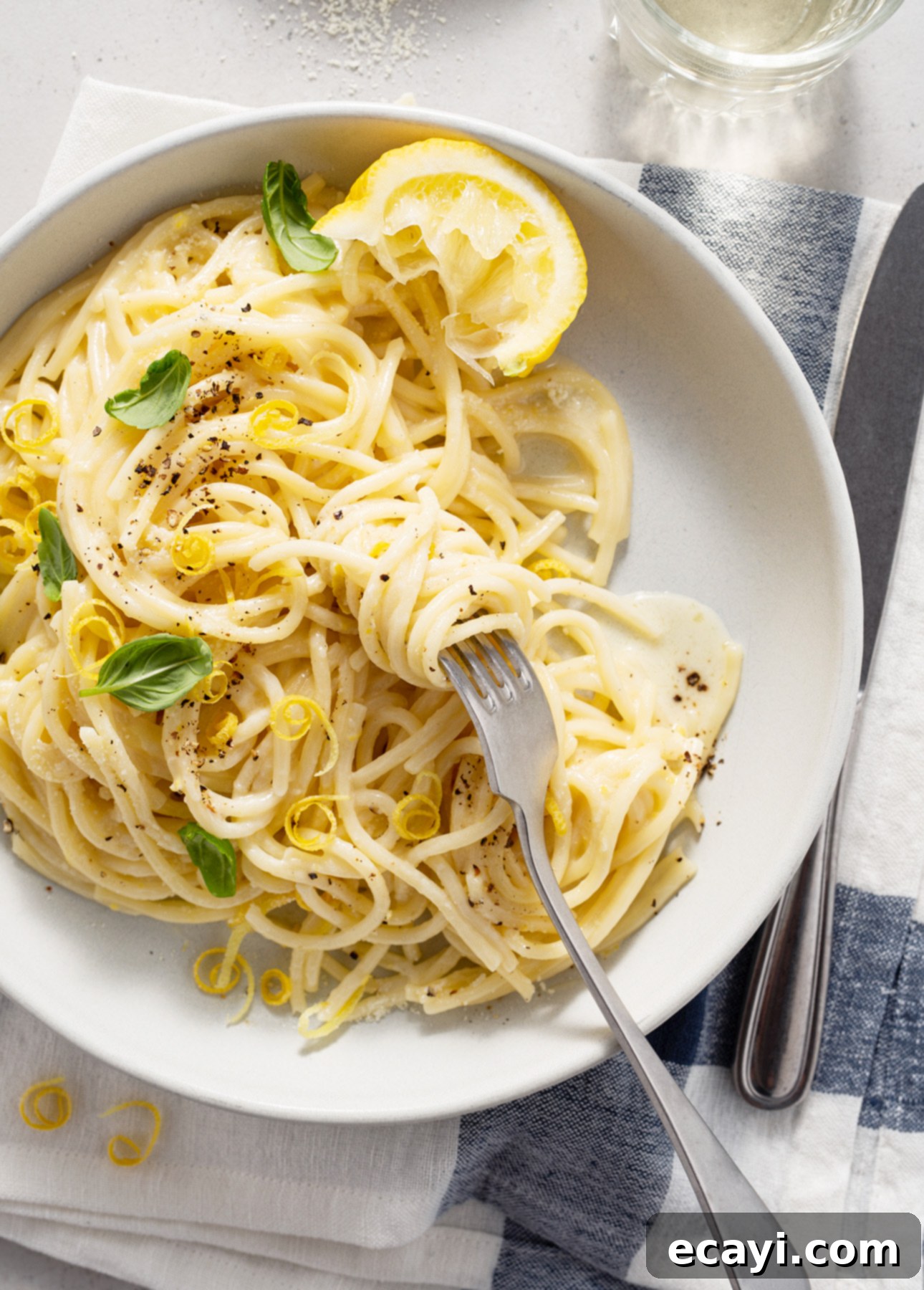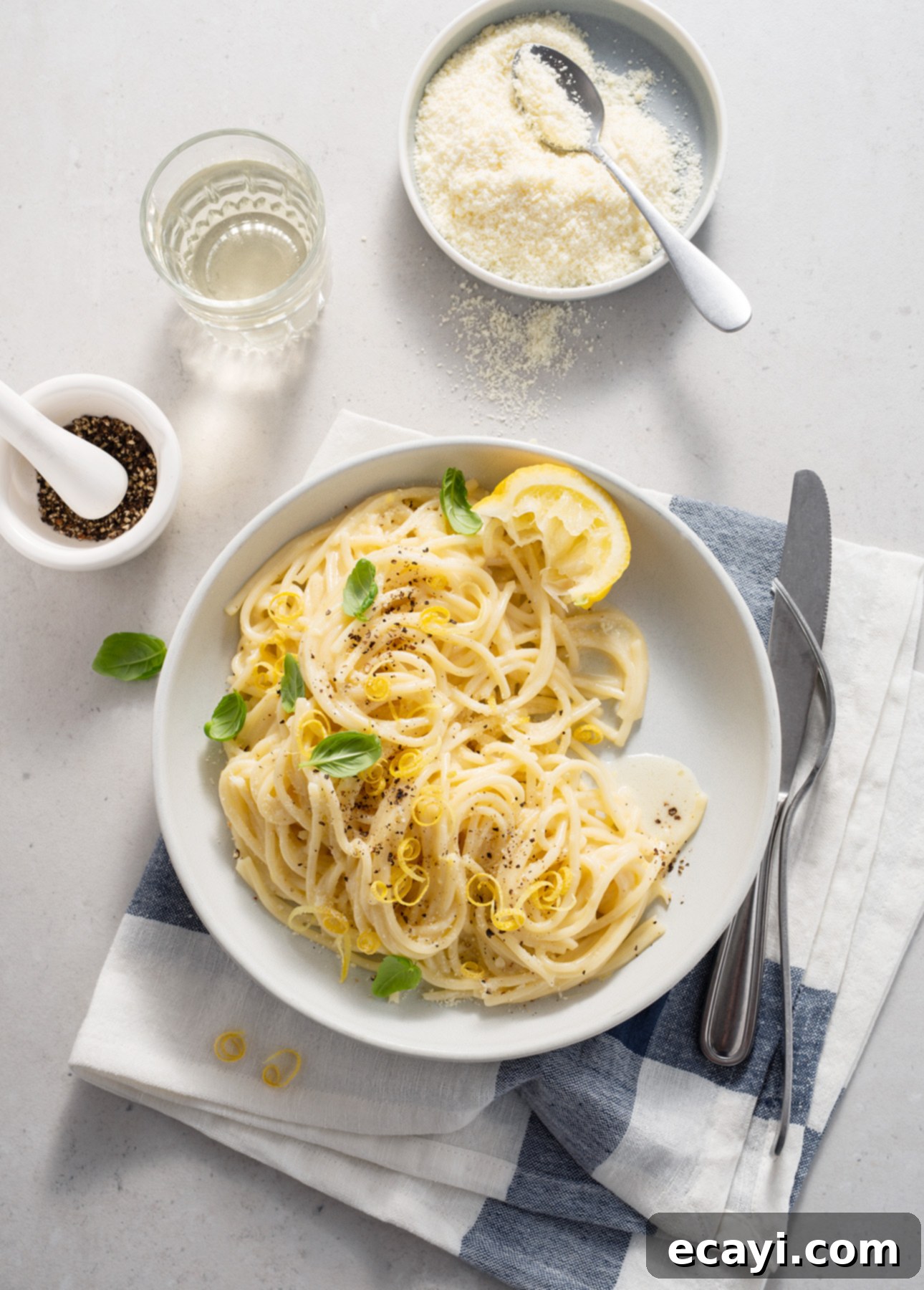Easy Creamy Spaghetti al Limone: Your Ultimate 5-Ingredient Lemon Pasta Recipe
Looking for a dish that offers comfort, flavor, and incredible ease? Spaghetti al Limone is your answer! This delightful creamy lemon pasta will undoubtedly captivate fans of classic comfort foods like mac’n’cheese and the sophisticated simplicity of Cacio e Pepe. Crafted with just five essential ingredients, this recipe delivers a truly satisfying culinary experience. Enjoy it as a standalone masterpiece, or elevate it by folding in fresh vegetables and/or proteins for a heartier, more complete meal that suits any occasion.
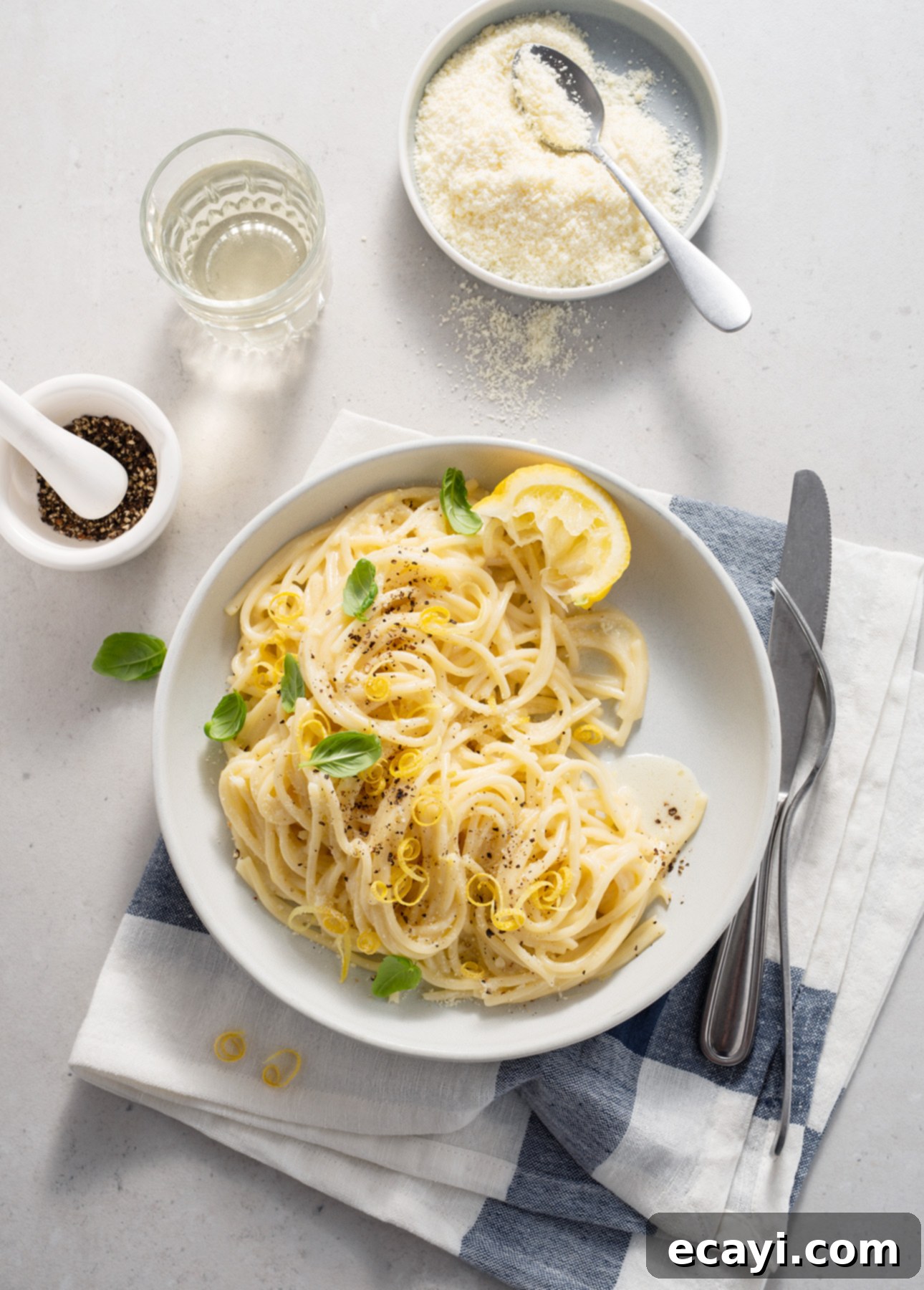
This post contains affiliate links. Full disclosure is at the bottom of the article.
When the clock is ticking on busy weeknights (which, let’s be honest, feels like most nights), my immediate go-to in the kitchen is always dry pasta. My pantry shelves are always well-stocked with various shapes and sizes! While it’s often tempting to create an impromptu “everything but the kitchen sink” kind of meal, I’ve discovered a profound truth: a truly authentic Italian classic can be just as quick, if not quicker, to prepare. When it comes to striking the perfect balance between speed and spectacular flavor, my absolute, hands-down favorite is undoubtedly this incredible Spaghetti al Limone.
Of course, we still cherish our other beloved Italian pasta classics. Bucatini all’Amatriciana is a phenomenal dish (I always keep a stash of guanciale in the freezer specifically for it), and Cacio e Pepe remains a cheesy masterpiece that never fails to impress. However, this remarkably easy, creamy lemon pasta consistently earns the “favorite weeknight dish” award in my household, every single time. Its bright, comforting flavor profile makes it an unbeatable choice.
Spaghetti al Limone truly encompasses everything you adore about a great pasta dish: it’s luxuriously creamy, wonderfully cheesy, incredibly zesty, and profoundly satisfying. What I appreciate most about this recipe is its versatility; it’s absolutely spectacular served on its own, yet it also serves as a perfect canvas for any last-minute additions. For a quick boost of greens, I frequently toss in a couple of handfuls of tender baby spinach and let them gently wilt into the hot pasta. If I happen to have some leftover roasted chicken, I’ll shred it and fold it right in. I’ve even elevated this humble dish into a gourmet offering, topping it with succulent lobster meat for a memorable dinner party!
The fundamental recipe for Spaghetti al Limone remarkably requires only five simple ingredients—and that count includes the pasta itself! Honestly, mastering this creamy lemon sauce is even simpler than perfecting Cacio e Pepe, which typically demands a bit more practice and technique. Furthermore, another incredibly practical advantage of this dish is that it reheats wonderfully, making it ideal for meal prep or enjoying delicious leftovers the next day!
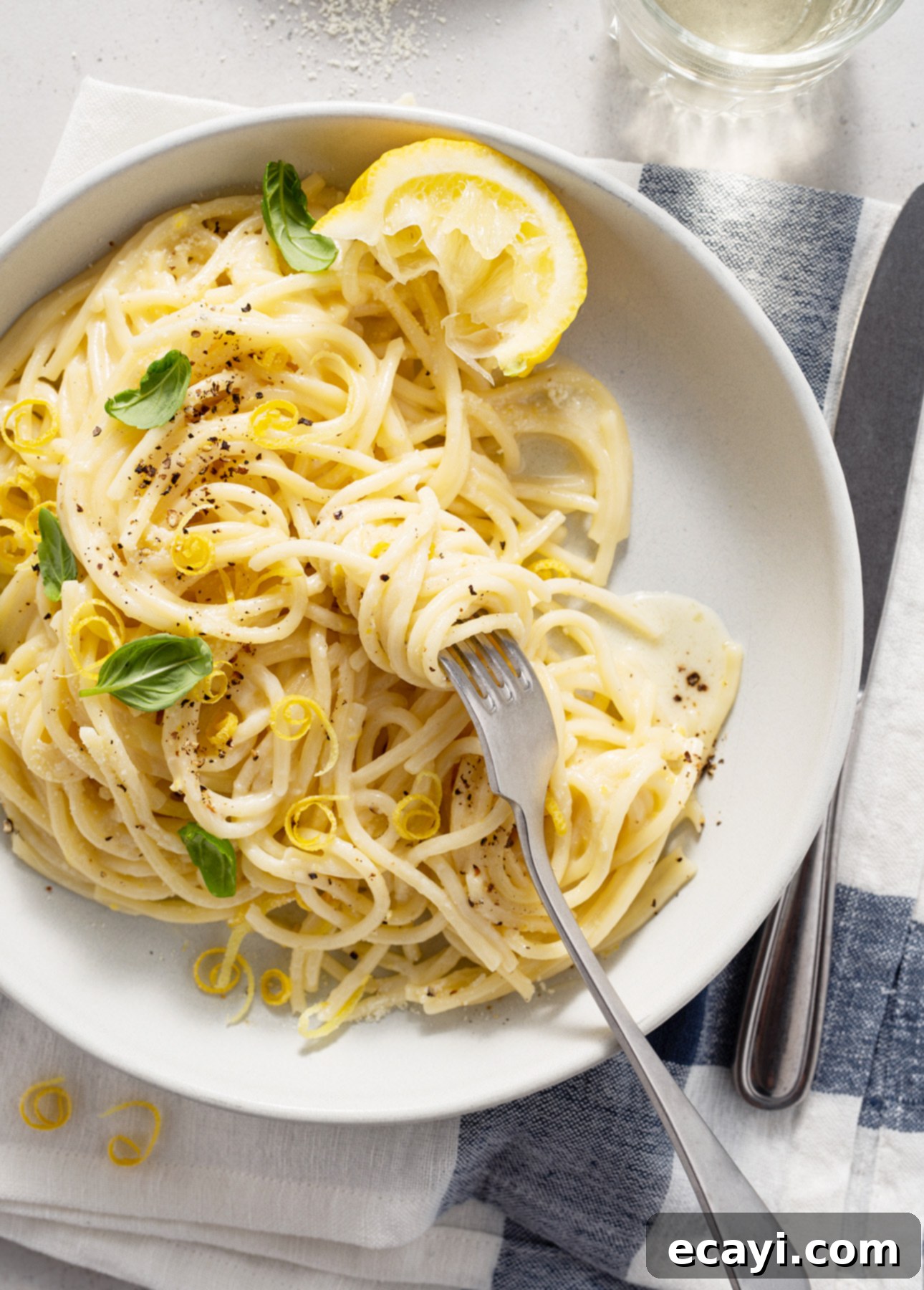
A quick note regarding the evolution of this recipe: My personal Spaghetti al Limone recipe is an adaptation inspired by a version found in Bon Appétit magazine. However, over the years, I’ve meticulously refined and customized it, most notably by significantly reducing the quantities of heavy cream and butter initially called for. Through extensive experimentation, I discovered that by cleverly utilizing more starchy pasta cooking water and incorporating a slightly increased amount of rich Parmigiano-Reggiano cheese into the sauce, you can achieve a sauce that is just as irresistibly silky and decadent, but with a much lighter feel. My goal is always to provide you with delicious, better-for-you weeknight dinner options that don’t compromise on flavor! 🙌🏼
Helpful Tips for Crafting the Perfect Spaghetti Al Limone
What Exactly is Pasta al Limone?
The name of this pasta dish is as elegantly simple as the recipe itself. “Al Limone” translates quite literally to “with lemon.” This signature bright, intensely lemony, and remarkably silky sauce is created through a culinary alchemy, emulsifying luxurious fats, starchy pasta water, and rich cheese with the vibrant, fresh essence of lemon. The result is a harmonious blend of textures and flavors that is both comforting and invigorating.
Where Does Pasta al Limone Originate From?
Pasta al Limone traces its delectable roots to Southern Italy, specifically the sun-drenched region of Campania. This geographical origin makes perfect sense, as Campania is the proud home of the world-renowned, incredibly fragrant lemons cultivated along the breathtaking Amalfi Coast and in Sorrento. The flavor profile of creamy lemon pasta is a beautiful symphony: it’s bright and tangy from the lemon, intensely savory and umami-rich from the cheese, and gains an irresistible, opulent touch from the cream. Each spoonful truly feels like pure sunshine captured in a bowl. It’s a dish that embodies the warmth and vibrant flavors of its Italian birthplace.
A rustic crate brimming with aromatic Amalfi lemons.
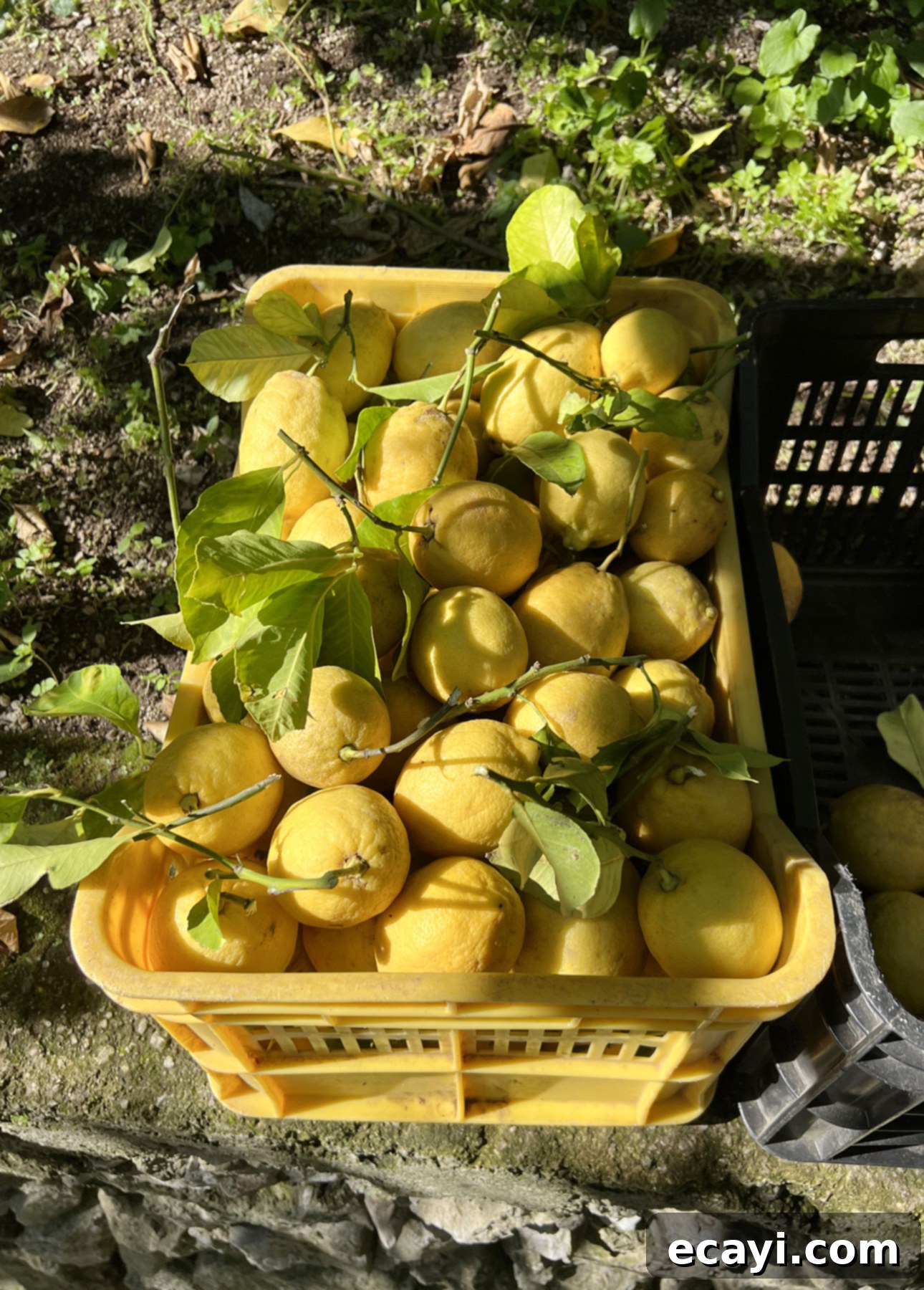
What Ingredients Do I Absolutely Need?
The inherent beauty of this recipe lies in its incredibly short and concise ingredient list. This means that the quality of each individual ingredient truly stands out and makes a significant difference in the final taste and texture of your dish.
- Pasta: While Spaghetti is the quintessential and classic choice that lends its name to this dish, other long pasta shapes are also wonderfully suitable (we’ll delve into more options below!). If you can possibly find “bronze-cut” (also known as “bronze-die”) pasta, it is absolutely ideal for this particular recipe. Bronze-cut pasta has a slightly rougher, more porous surface texture, which allows it to release more beneficial starch into the cooking water. This extra starch is a crucial element, as it helps to thicken and give a velvety body to the lemon sauce. Most well-stocked grocery stores now carry bronze-cut pasta. When shopping, try to look beyond the large multinational brands and seek out packaging with authentic Italian writing or a more artisanal appearance. Many traditional bronze-cut pasta brands are sold in intricately designed paper bags rather than standard cardboard boxes. Some major brands, such as Barilla, have introduced their own “bronze-cut” lines of pasta, often labeled as “artisanal.” Always double-check the packaging for the words “bronze-cut” to ensure you’re selecting the right product.
- Lemons: These are undeniably the star of our dish! Since the recipe calls for both the fragrant zest and the tangy juice, I highly recommend sourcing organic, unwaxed lemons if they are available to you. If you’re using conventional lemons, make sure to give them a thorough scrub with warm water before incorporating them into the recipe to remove any potential wax or residues. And please, whatever you do, don’t even consider using bottled lemon juice! Freshness is paramount here.
- Fat: My thoughtfully adapted “better-for-you” recipe employs a carefully balanced combination of rich heavy cream and silky butter. This blend ensures a foolproof, perfectly silky texture for the sauce that is decadent without feeling overly heavy or greasy. Each fat plays a specific role in achieving that perfect mouthfeel.
- Cheese: This ingredient is absolutely fundamental to both the deep, savory flavor and the luscious creaminess of the sauce. Which naturally brings me to my next critical point…
Why Authentic Parmigiano-Reggiano is an Absolute Must
When a recipe’s ingredient list is as refreshingly short as this one, the quality of each component becomes exponentially more important. To achieve the most exquisite and delicious version of Spaghetti al Limone, you truly need to use the finest ingredients you can find and reasonably afford. When preparing this dish, do not skimp on using genuine Parmigiano-Reggiano cheese. This remarkable cheese boasts a distinctively sharp, complexly nutty, and perfectly salty flavor profile that imparts an incredible depth of taste and an unforgettable creaminess to the entire dish.
Authentic Parmigiano-Reggiano is a product protected under a rigorous “Protected Designation of Origin” (PDO) status. This strict designation means that it must be produced following very specific traditional methods within an exclusive, defined region of Italy to legally bear its distinguished name. To identify true Parmigiano-Reggiano, look for its characteristic stamped rind, verify that it has been aged for a minimum of 12 months, and ensure it is explicitly labeled with its original Italian name (as opposed to the generic “Parmesan” which can be produced anywhere). Investing in this high-quality cheese will truly elevate your Spaghetti al Limone from good to extraordinary.
Yes, authentic Parmigiano-Reggiano is undeniably more expensive than generic cheese products labeled merely “Parmesan.” However, you don’t need a massive quantity to make your dishes exceptionally special. Reserve it for recipes where its unique, profound flavor can truly shine and be appreciated, such as rich risottos, vibrant salads, and of course, this delightfully creamy lemon spaghetti!
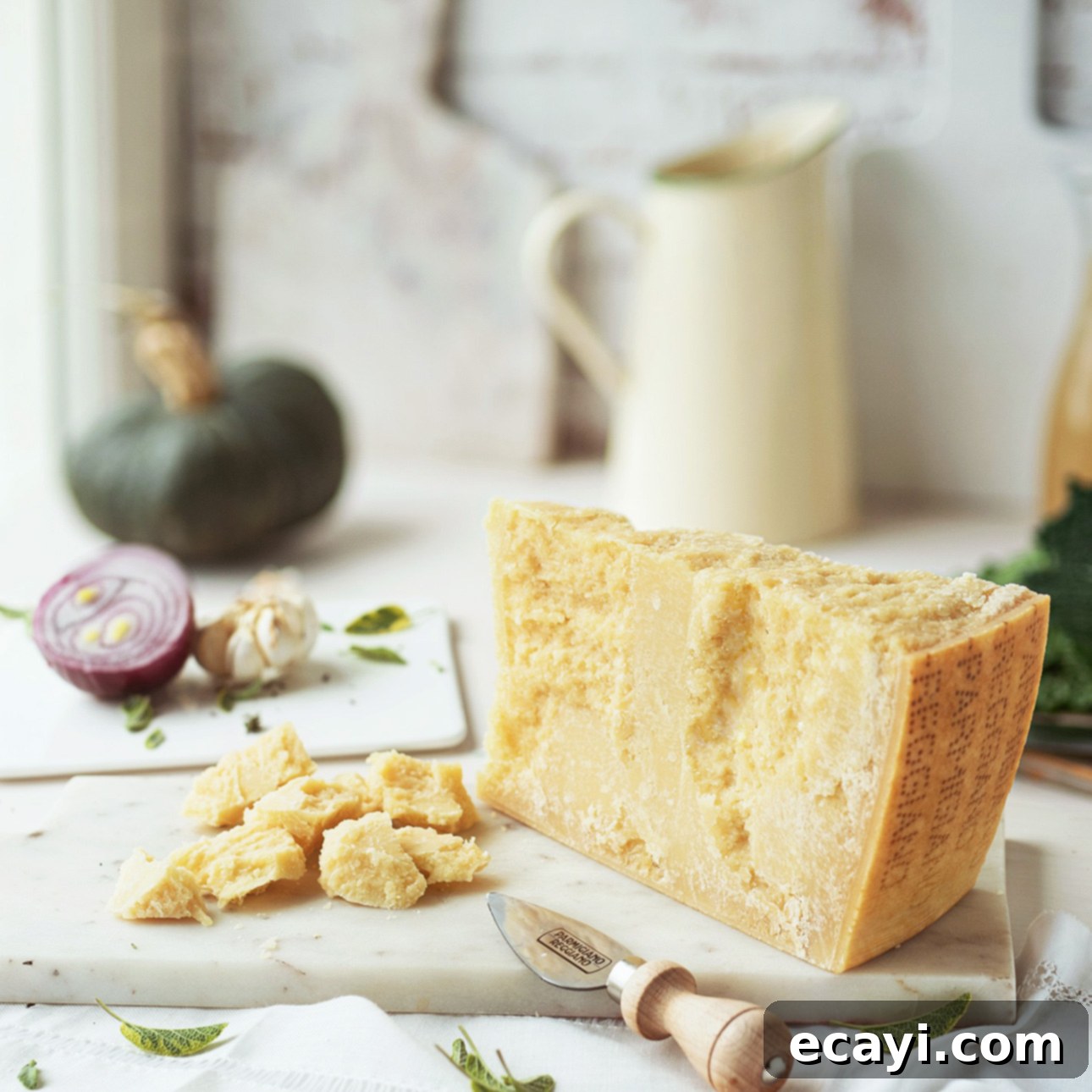
The Secret to the Best Lemon Flavor (Zest vs. Juice)
To achieve a truly profound, multifaceted lemon flavor that transcends a simple one-note sourness, it is absolutely essential to utilize both the zest and the juice of the lemon. The zest—the bright yellow outer peel, meticulously grated with a microplane—is a treasure trove of fragrant essential oils. These oils are packed with the delicate, floral, and aromatic compounds that give lemon its signature perfume. When you incorporate the zest into the cream and butter as they gently heat, it thoroughly infuses the entire sauce base with that exquisite, beautiful lemon fragrance.
The lemon juice, conversely, is what provides that invigorating, bright, and tangy kick. To preserve its fresh, vibrant acidity and prevent it from becoming muted or bitter, always add the fresh lemon juice at the very end of the cooking process, after removing the pan from the heat. This two-pronged approach ensures a complex and perfectly balanced lemon flavor throughout your pasta.
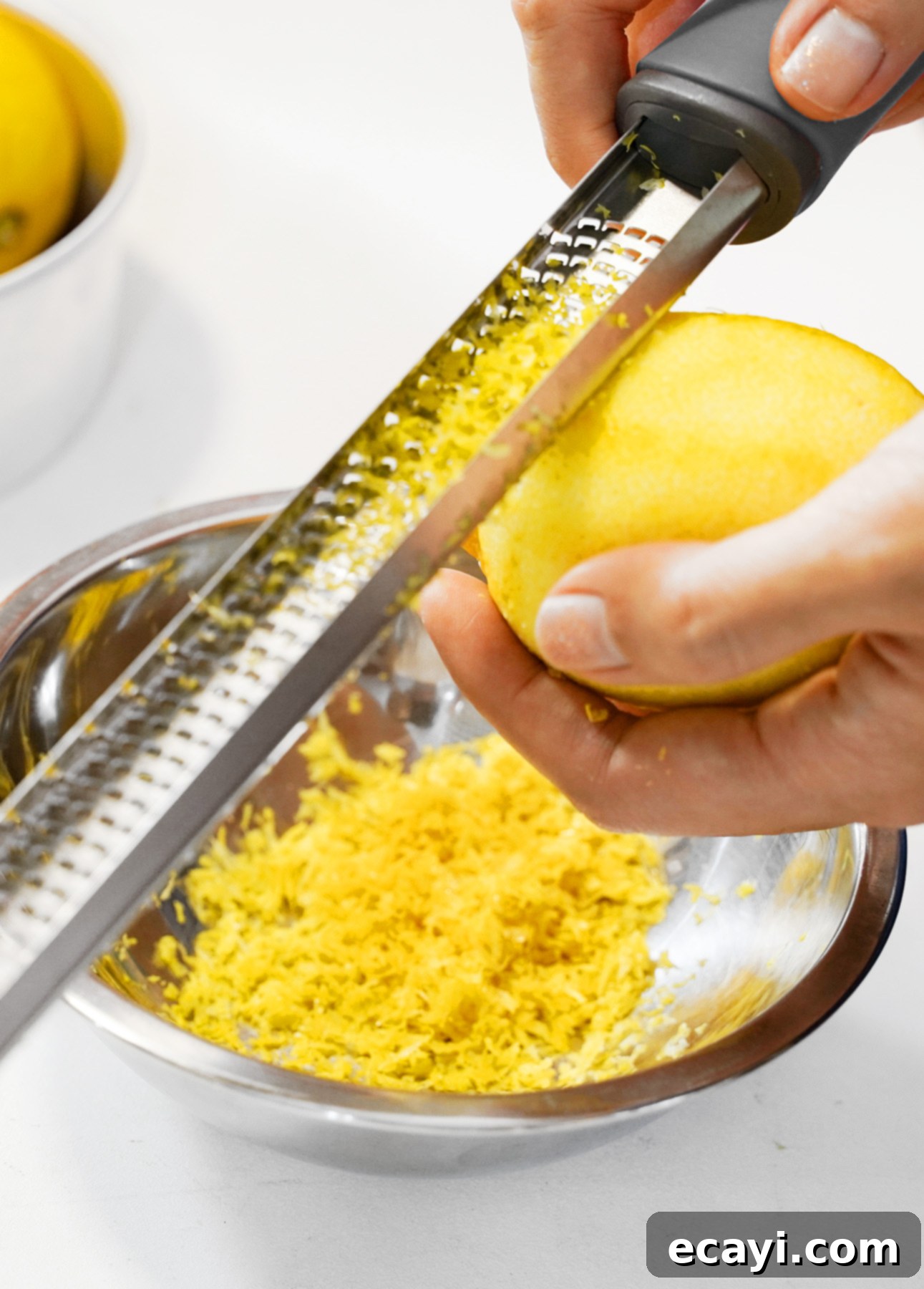
Troubleshooting: Help! Why Did My Cheese Clump?
There’s nothing more frustrating in cooking than anticipating a beautiful, creamy lemon pasta and instead being met with a stringy, clumpy mess. Believe me, I’ve certainly been there!
This common issue can typically be attributed to one or a combination of these critical factors: the heat under your pan was too high, your cheese wasn’t grated finely enough, or you added it all at once in a large quantity.
Hard, aged cheeses like Parmigiano-Reggiano are particularly sensitive. They contain a specific balance of proteins and fats that will seize up, break apart, and develop a stringy, unappetizing texture if exposed to a pan that is simmering too aggressively or is excessively hot. Additionally, if the cheese isn’t grated very finely (ideally with a microplane), its larger particles won’t melt as evenly or smoothly. And attempting to dump a large pile of cheese into a piping hot sauce almost guarantees the formation of stubborn clumps!
HOW TO FIX THIS: First and foremost, ensure you are grating your Parmigiano-Reggiano as finely as possible, with a microplane being the superior tool for this task. This fine texture significantly aids in achieving a silky, uniform melt. Second, and crucially, always, always reduce the heat to low or even turn it off completely before you begin incorporating the cheese. Then, the trick is to add the cheese gradually, just a couple of spoonfuls at a time, stirring or whisking constantly. The residual heat from the freshly cooked pasta and the warm sauce will provide sufficient gentle warmth to melt the cheese slowly and smoothly, allowing it to emulsify into that glossy, perfect sauce you’re aiming for.
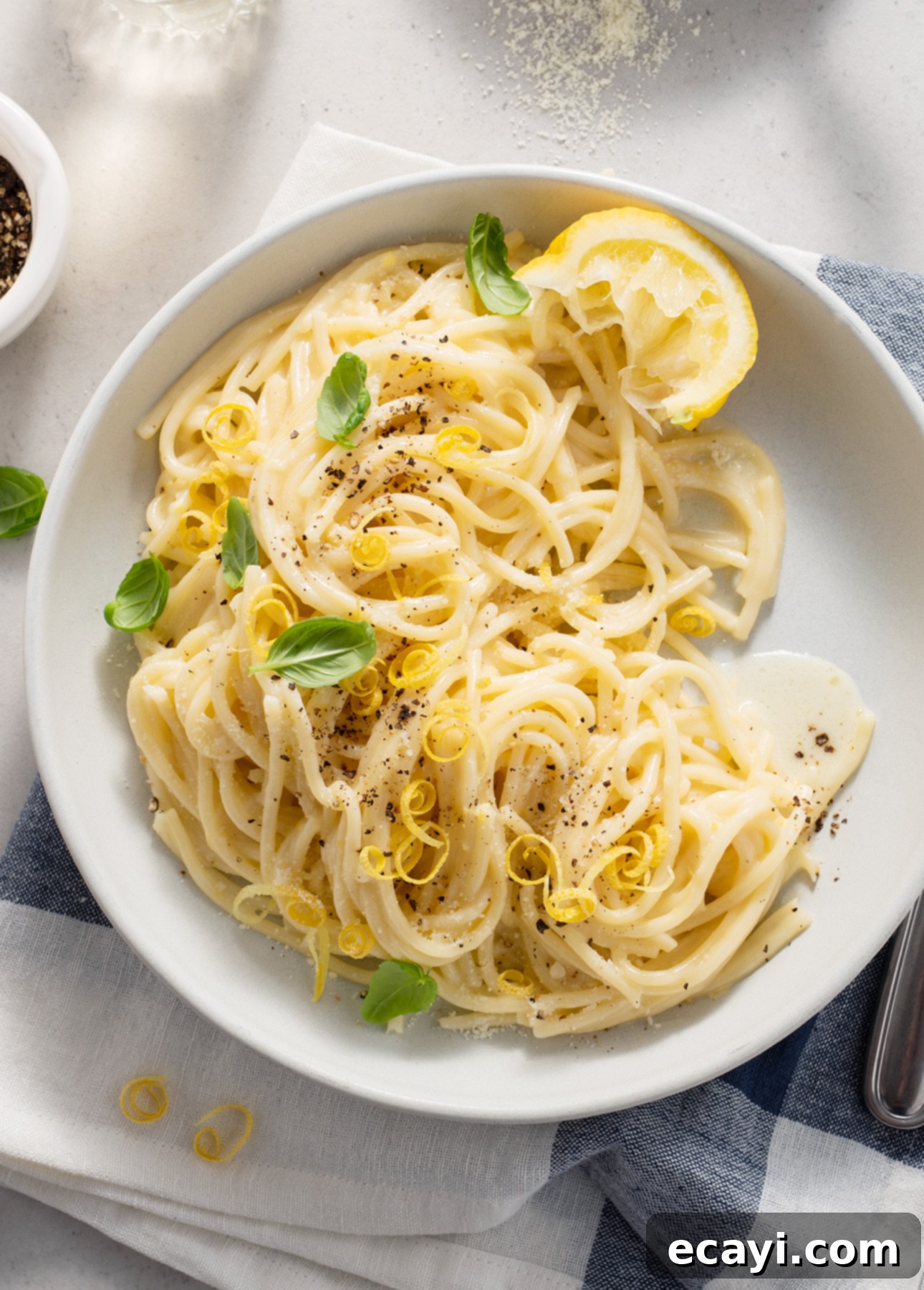
Can I Use a Different Pasta Shape?
Absolutely! While spaghetti is the traditional choice and the namesake of this delicious dish, this luscious, lemony creamy sauce is incredibly versatile and will beautifully coat almost any type of pasta. Other long pasta shapes such as elegant linguine, hollow bucatini, or broad tagliatelle are fantastic alternatives, as their elongated forms provide ample surface area for the sauce to cling to. Even shorter, more intricate shapes like spiral fusilli or tubular penne work exceptionally well, as that silky sauce effortlessly gets trapped and held within all their delightful nooks and crannies, ensuring every bite is bursting with flavor.
Multitask to Shorten Your Road to Deliciousness
Spaghetti al Limone is designed to come together incredibly quickly, making it a perfect weeknight meal. The most efficient way to prepare it and significantly reduce your cooking time is by expertly multitasking and following these streamlined steps:
- Begin by filling a large pot with a generous amount of water and placing it over high heat.
- While you patiently wait for the water to reach a rolling boil, efficiently prepare all your necessary ingredients as detailed in the ingredient list: accurately measure out the heavy cream, precisely cut the butter into cubes, and finely grate the Parmigiano-Reggiano cheese. Arrange everything conveniently by your stove, creating a well-organized mise en place.
- Once the water is boiling vigorously, add the pasta. Simultaneously, while the pasta is happily cooking, start preparing the rich lemon sauce in a large skillet, following the method instructions.
- When the pasta is perfectly al dente (or slightly undercooked, as detailed below), use tongs to transfer it directly from the pot into the skillet containing the sauce. It’s not only okay but actually beneficial if some of the starchy pasta cooking water transfers along with it. Make sure to keep at least a mugful of extra pasta cooking water nearby; this “liquid gold” is essential for adjusting the consistency of your sauce later, if needed.
- Return the skillet, now holding both the sauce and the pasta, to a gentle simmer over medium-low heat to finish the cooking process. Stir in the fresh lemon juice at this stage for maximum brightness, and then – DIG IN and enjoy your masterpiece!
How (and Why) to Perfectly Salt Your Pasta Water
Take my expert word for it: the absolute secret to truly delicious pasta begins with salting your pasta water correctly. This might seem like the simplest first step in any pasta recipe, yet it’s surprisingly the one that most people unfortunately overlook! Salting your pasta water is your one and only opportunity to infuse flavor directly into the pasta itself, from the inside out, as it cooks.
But here’s another crucial piece of information: that starchy, perfectly salted water is truly liquid gold. It’s a non-negotiable, key ingredient that plays a vital role in helping our creamy lemon sauce achieve its coveted silky texture, glossy appearance, and impeccably seasoned flavor. If the pasta water is bland, you are simply adding blandness into your exquisite sauce. It’s as straightforward as that.
So, how much salt should you confidently add to the pot? Be brave and generous! For a large pot of water (typically 4-6 quarts), you should add at least a small handful of coarse salt, roughly 1 to 2 tablespoons. The Italians famously say the water should taste “like the sea,” and they are not exaggerating. Don’t just lightly sprinkle it in; give it a real, purposeful dose!
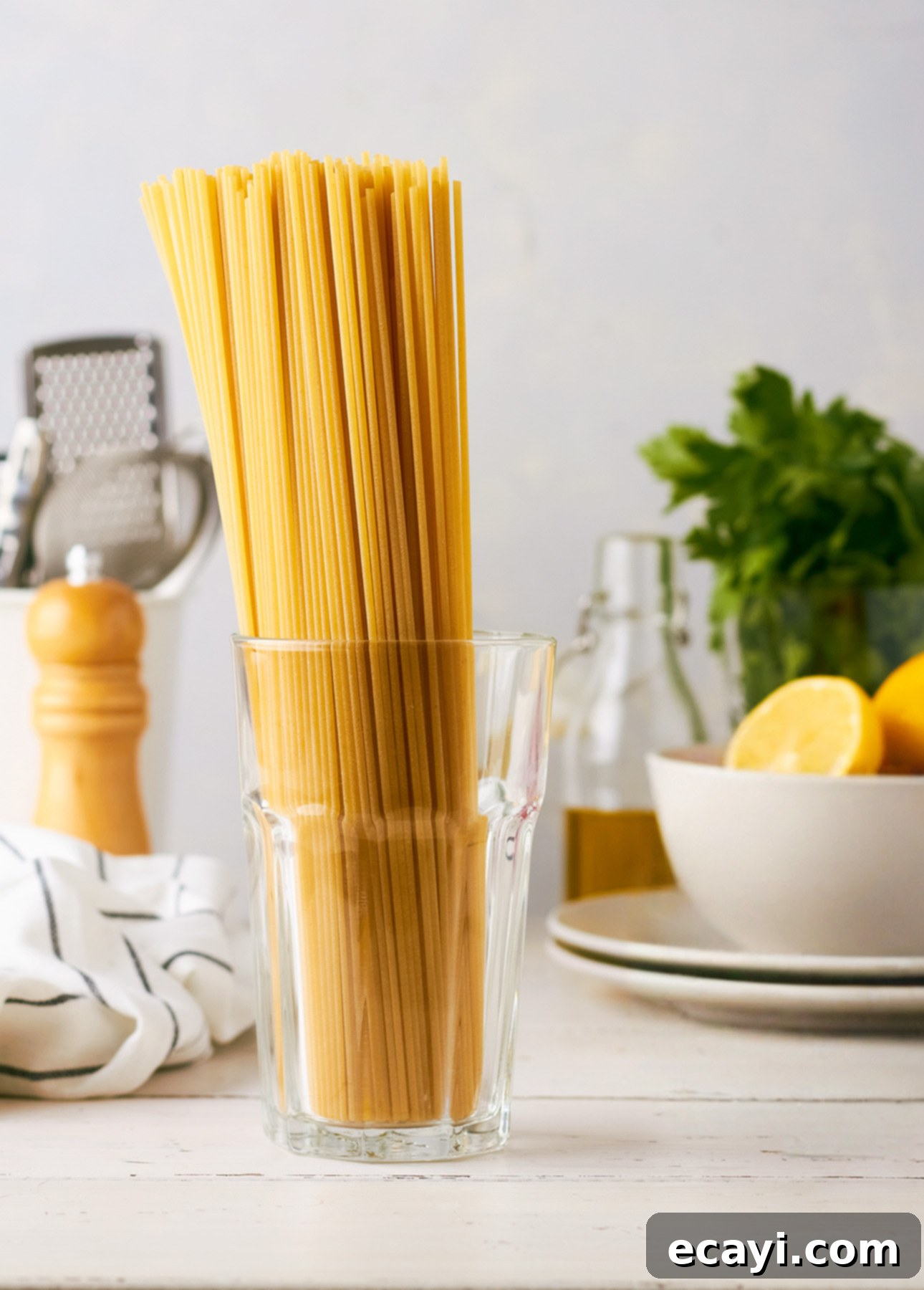
The Secret: Finish Cooking the Pasta in the Sauce
Do you want to know a tried-and-true chef’s secret that will make any pasta dish taste like it just came from a renowned Italian restaurant? It’s incredibly simple: finish cooking the pasta directly in the sauce. This technique is a complete game-changer, transforming ordinary pasta into something truly extraordinary.
Here’s precisely how you execute it: first, check the pasta box for the recommended al dente cooking time, and then set your kitchen timer for two full minutes less than that duration. When the timer signals, test a piece of pasta; it should still be noticeably firm and slightly resistant in the center. This “underdone” stage is absolutely perfect.
Now, here’s the critical part: forget about the colander—whatever you do, under no circumstances drain that precious pasta water down the sink! You absolutely need that starchy water. Instead, use a pair of tongs to carefully pull the noodles directly from the boiling pot and transfer them straight into the skillet containing your prepared sauce. Before you do this, make sure you reserve a large mugful of that indispensable starchy water. As you gently toss everything together over the heat, the slightly undercooked pasta will continue to cook, absorbing all that glorious lemony, creamy goodness from the sauce, ultimately reaching a perfect al dente texture. This method ensures every strand is infused with flavor and the sauce emulsifies beautifully. It’s a total game-changer for achieving restaurant-quality results at home.
What to Serve with Spaghetti al Limone
This creamy lemon pasta is a true star, capable of shining brilliantly all on its own, especially when served hot with an extra dusting of grated cheese and a fresh twist of fragrant black pepper. But as I’ve mentioned, its inherent simplicity makes it the perfect canvas for culinary creativity and personalized additions!
- Veggies: My absolute favorite way to enhance this dish is by simply stirring two generous handfuls of tender baby spinach into the hot pasta, tossing just until the spinach gently wilts into the creamy sauce. Sautéed asparagus spears or fresh green peas (which can be blanched alongside the pasta during its last minute of cooking) are also incredible, adding vibrant color and fresh flavor.
- Protein: Spaghetti al Limone pairs exceptionally well with simple, delicate proteins. Consider quickly sautéed shrimp for a touch of elegance, or incorporate leftover shredded roasted chicken for an easy, hearty addition. To truly elevate the dish for a special occasion, serving it with luxurious lobster meat is an unforgettable experience!
- Wine: When selecting a wine, keep it crisp and refreshing to complement the bright lemon notes. A dry Italian white wine, such as a crisp Pinot Grigio, or even a Vermentino, will beautifully cut through the richness of the creamy sauce, offering a delightful contrast and enhancing the overall dining experience.
How to Reheat Creamy Lemon Pasta
This delightful pasta recipe yields four generous servings, making it perfect for a family meal or providing delicious leftovers. If you find yourself with any extra, you’ll be pleased to know that you can reheat them with remarkable ease and without sacrificing quality. Simply transfer your refrigerated leftovers back into a pan with a small splash of water or a tiny bit of extra cream. Reheat gently over low heat, stirring occasionally, and watch as the wonderful sauce miraculously returns to its glossy, irresistible glory in just a few minutes. It will taste almost as fresh as the day you made it!
Savory Citrus Delights Cookbook
Do you adore savory citrus recipes as much as we do? Then you’ll absolutely fall in love with my Savory Citrus Delights Cookbook! In this captivating collection, you’ll discover invigorating, zesty variations on timeless classics, learn to create colorful and nutritious lunches, and effortlessly expand your weeknight dinner repertoire with aromatic, inventive dishes that the entire family will cherish. Savory Citrus Delights is a comprehensive 16-recipe downloadable eBook, delivered in a convenient, universally compatible PDF format that you can save and access anywhere! LEARN MORE AND GET YOUR COPY TODAY!
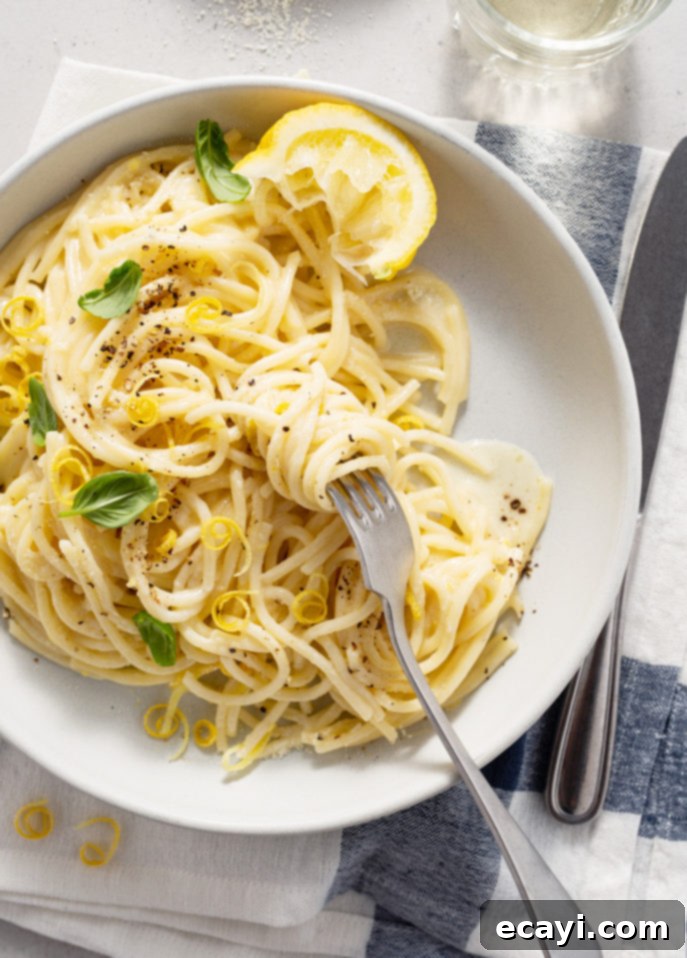
Pin Recipe
Spaghetti al Limone (Creamy Lemon Spaghetti)
Ingredients
- 12 oz dry spaghetti pasta
- ½ cup heavy cream (35% m.f.) or coffee cream (10 to 15% m.f.)
- 1 lemon, scrubbed clean
- ¼ cup butter, cut into cubes
- 3 oz very finely grated Parmigiano-Reggiano (using a Microplane to grate the cheese is best)
- Freshly ground black pepper
Optional Garnishes (use any or all or none at all)
- 2 handfuls baby spinach
- 1 cup cooked shrimp, or diced cooked chicken
- Fresh basil leaves
Instructions
-
Bring a large pot of heavily salted water to a rolling boil. Add the spaghetti pasta to the boiling water and set a timer for 2 minutes less than the cooking time recommended by the manufacturer (this is crucial as the pasta will continue to cook and absorb flavor in the sauce later.)
-
While the pasta is actively cooking, position a large nonstick pan over medium heat. Pour in the heavy cream, then carefully and very finely grate the zest of the lemon directly into the cream (using a Microplane is highly recommended for the best texture). Stir the lemon zest into the cream and allow the cream to come to a gentle simmer. Begin incorporating the butter, adding it 1 or 2 cubes at a time, whisking continuously to emulsify the butter into the cream as it melts. Gradually add more cubes, maintaining constant whisking throughout. (Continuous whisking is the key to creating a perfectly smooth, emulsified sauce.)
-
Once all the butter has been fully incorporated and the sauce is smooth, reduce the heat to low (or turn it off completely for a moment). Begin sprinkling the finely grated Parmigiano-Reggiano over the sauce. Add the cheese very gradually, a spoonful at a time, and continue whisking constantly to ensure the cheese melts smoothly and fully incorporates into the sauce. Repeat this process until all the Parmigiano-Reggiano is added and melted. (Adding the cheese slowly and gradually at a lower temperature is essential to prevent it from clumping and ensures a super smooth, silky sauce.) Turn off the heat completely from the pan.
-
When the pasta timer sounds, use sturdy tongs to transfer the al dente pasta directly from its pot to the pan containing the creamy lemon sauce. It is perfectly fine, and even beneficial, if some of the starchy pasta cooking water comes along with the noodles. Crucially, DO NOT discard the pasta water, as you will need some of it to achieve the perfect consistency for the finished dish.
-
Return the saucepan with the pasta and sauce to medium heat. Add ½ cup (125 ml) of the reserved pasta water to the pan and stir everything together to combine thoroughly. Bring the sauce back to a gentle simmer and let it cook for 1-2 minutes, stirring continuously, until the sauce visibly thickens around the pasta, just enough to beautifully coat each strand. A small amount of sauce should still pool elegantly at the bottom of the pan, but if there’s still a lot of loose, watery sauce, continue simmering for a bit longer until the texture appears just right – glossy and creamy.
-
Remove the pan from the heat. Squeeze the fresh juice from your zested lemon directly into the dish and stir it in immediately. Season the pasta generously with a very liberal amount of freshly ground black pepper. (Younger diners or those with milder palates might prefer less black pepper!)
-
If you are choosing to add baby spinach and/or protein, stir them into the hot pasta now and cook for just a few additional seconds, only until the spinach visibly wilts and loses its volume, or the protein is heated through. If the sauce becomes too thick, add a tiny bit more of the reserved pasta water to maintain a luscious, saucy consistency. Garnish with fresh basil leaves, if desired, for an extra burst of freshness and color. Serve this magnificent dish immediately to enjoy it at its best.
Did you make this?
Tell me how you liked it! Leave a comment or take a picture and tag it with @foodnouveau on Instagram.
Disclosure Notice: This site is a participant in the Amazon Associates Program, an affiliate advertising program designed to provide a means for the site to earn fees by linking to Amazon and affiliated sites.
If you click on an affiliate link, I may earn advertising or referral fees if you make a purchase through such links, at no extra cost to you. This helps me create new content for the blog–so thank you! Learn more about advertising on this site by reading my Disclosure Policy.
